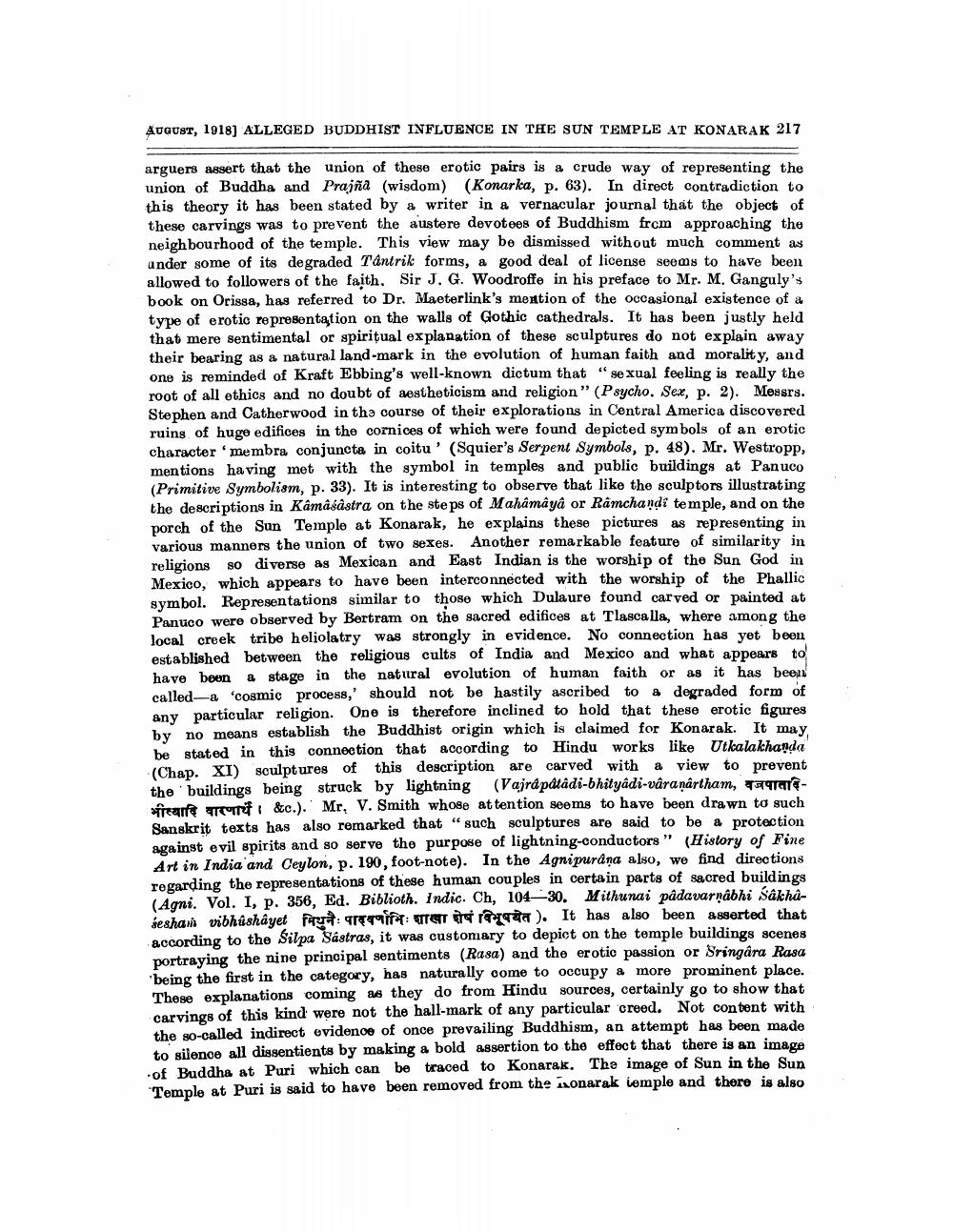________________
AUGUST, 1918) ALLEGED BUDDHIST INFLUENCE IN THE SUN TEMPLE AT KONARAK 217
arguers assert that the union of these erotic pairs is a crude way of representing the union of Buddha and Prajña (wisdom) (Konarka, p. 63). In direct contradiction to this theory it has been stated by a writer in a vernacular journal that the object of these carvings was to prevent the austere devotees of Buddhism from approaching the neighbourhood of the temple. This view may be dismissed without much comment as under some of its degraded Tantrik forms, a good deal of license seems to have been allowed to followers of the faith. Sir J. G. Woodroffe in his preface to Mr. M. Ganguly's book on Orissa, has referred to Dr. Maeterlink's mention of the occasional existence of a type of erotic representation on the walls of Gothic cathedrals. It has been justly held that mere sentimental or spiritual explanation of these sculptures do not explain away their bearing as a natural land-mark in the evolution of human faith and morality, and one is reminded of Kraft Ebbing's well-known dictum that “sexual feeling is really the root of all ethics and no doubt of aestheticism and religion” (Psycho, Sex, p. 2). Messrs. Stephen and Catherwood in the course of their explorations in Central America discovered ruins of huge edifices in the cornices of which were found depicted symbols of an erotic character membra conjuncta in coitu' (Squier's Serpent Symbols, p. 48). Mr. Westropp, mentions having met with the symbol in temples and public buildings at Panuco (Primitive Symbolism, p. 33). It is interesting to observe that like the sculptors illustrating the descriptions in Kamasastra on the steps of Mahâmâyâ or Ramchandi temple, and on the porch of the Sun Temple at Konarak, he explains these pictures as representing in various manners the union of two sexes. Another remarkable feature of similarity in religions so diverse as Mexican and East Indian is the worship of the Sun God in Mexico, which appears to have been interconnected with the worship of the Phallic symbol. Representations similar to those which Dulaure found carved or painted at Panuco were observed by Bertram on the sacred edifices at Tlascalla, where among the local creek tribe heliolatry was strongly in evidence. No connection has yet been established between the religious cults of India and Mexico and what appears to have been a stage in the natural evolution of human faith or as it has been called a "cosmic process,' should not be hastily ascribed to 4 degraded form of any particular religion. One is therefore inclined to hold that these erotic figures by no means establish the Buddhist origin which is claimed for Konarak. It may be stated in this connection that according to Hindu works like Utkalakhanda (Chap. XI) sculptures of this description are carved with a view to prevent the buildings being struck by lightning (Vajrá pdládi-bhityadi-váranârtham, TRITAfeur
&c.). Mr. V. Smith whose attention seems to have been drawn to such Sanskrit texts has also remarked that "such sculptures are said to be a protection against evil spirits and so serve the purpose of lightning-conductors" (History of Fine Art in India and Ceylon, p. 190, foot-note). In the Agnipurâna also, we find directions regarding the representations of these human couples in certain parts of sacred buildings (Agni. Vol. I, p. 356, Ed. Biblioth. Indic. Ch, 104-30. Mithunai padavarnabhi Sakhâieshan vibhishayet मिथनः पाश्वर्णाभिः शाखा शेषं विभूषवेत). It has also been asserted that according to the Silpa Sastras, it was customary to depict on the temple buildings scenes
portraying the nine principal sentiments (Rasa) and the erotic passion or Sringara Rasa 'being the first in the category, has naturally come to occupy a more prominent place. These explanations coming as they do from Hindu sources, certainly go to show that carvings of this kind were not the hall-mark of any particular creed. Not content with the so-called indirect evidenoe of once prevailing Buddhism, an attempt has been made to silence all dissentients by making a bold assertion to the effect that there is an image of Buddha at Puri which can be traced to Konarak. The image of Sun in the Sun Temple at Puri is said to have been removed from the isonarak temple and there is also




